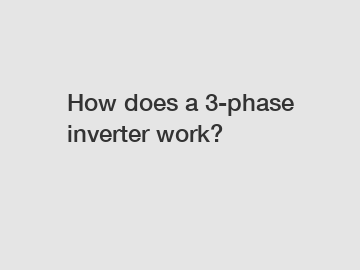How does a 3-phase inverter work?
How does a 3-phase inverter work?
A 3-phase inverter is a crucial component of an electrical system, converting DC power into AC power with three different phases. It plays a significant role in numerous applications like renewable energy systems, motor drives, and power grid integration. But how does a 3-phase inverter work? In this article, we will delve into the inner workings of this vital device, exploring its functioning, advantages, and applications.
1. Understanding the basics: A 3-phase inverter is a device that converts a DC voltage into three-phase AC voltage. It consists of six power transistors or switches, arranged in three pairs, with each pair corresponding to one phase. These switches are controlled by pulse width modulation (PWM) signals to generate the desired AC voltage waveform.

2. Generating the AC waveform: To generate the AC waveform, the inverter uses the switches to connect the DC voltage source to different combinations of the three-phase output terminals. By appropriately switching the transistors, the inverter creates a series of positive and negative voltage pulses, which, when connected to a load, form an AC waveform. The frequency and magnitude of the output voltage depend on the switching frequency and the amplitude of the DC voltage.
3. Pulse width modulation (PWM): The switches in the 3-phase inverter are controlled using PWM techniques. The PWM control method varies the width or duration of the switch-on time, resulting in different average voltages across the load terminals. By adjusting the width of the pulses, the inverter can provide precise control over the output voltage and frequency. This allows for efficient power transfer and regulation.
4. Advantages of 3-phase inverters: One key advantage lies in their ability to provide a more balanced and stable power output compared to single-phase inverters. Since three-phase power is commonly used in industrial and commercial applications, 3-phase inverters are an ideal choice for systems operating in such environments. They ensure efficient power distribution, reduce electrical losses, and minimize voltage drops.
5. Applications of 3-phase inverters: 3-phase inverters find extensive applications across various industries. They are widely used in renewable energy systems, such as solar power plants and wind turbines, to convert the DC power generated by the panels or turbines into usable AC power. Additionally, they are integral components in motor drives for electric vehicles and industrial machinery, delivering the required AC power to drive the motors. Furthermore, 3-phase inverters play a crucial role in power grid integration, assisting in the seamless connection between distributed power sources and the electrical grid.
6. Challenges with 3-phase inverters: While 3-phase inverters offer numerous advantages, they also come with some challenges. Designing and implementing these devices can be complex due to the need for synchronized control of the multiple switches and managing high currents. Moreover, the switching frequencies can introduce high harmonics, necessitating additional filtering and control mechanisms to meet electrical system requirements.
In conclusion, a 3-phase inverter is a pivotal component in numerous electrical systems, converting DC power into AC power for various applications. By using PWM control techniques, it generates a three-phase AC waveform, offering balanced power distribution and stable output. With their versatility and wide range of applications, 3-phase inverters have become indispensable in industries such as renewable energy, electric transportation, and power grid integration. Though they have their challenges, their benefits far outweigh the complexities involved in their implementation.
For more information, please visit shenzhen inverter, 5kw solar inverters, three phase and single phase inverters.
140
0
0

Comments
All Comments (0)